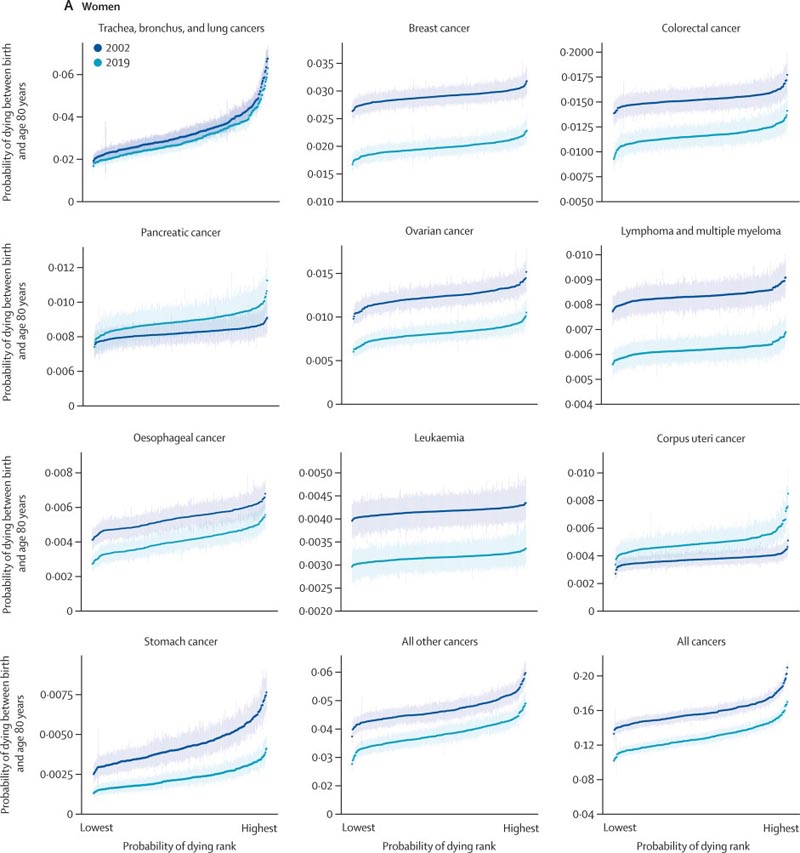Mortality from cancer in the UK and other industrialized countries has fallen more slowly than from other major causes of death and therefore the proportion of deaths from cancer has risen steadily for at least the last two decades.
Cancers are now the leading cause of death in England, overtaking cardiovascular disease.
Subnational data on cancer mortality trends are currently limited to large areas such as health boards or regions. Data from small areas can guide where primary prevention strategies are needed to reduce incidence and health care planning and delivery to improve survival. This evidence is particularly relevant for cancers, because their incidence and survival can be affected by a variety of risk factors, screening to detect precancerous lesions and early-stage disease, and effective treatments.
Small area data on cancer mortality can also help assess how cancers contribute to inequalities in all-cause mortality and life expectancy. We aimed to estimate trends in cancer mortality in 314 districts in England from 2002 to 2019 and assess their association with poverty.
Background
Cancers are the leading cause of death in England. Our aim was to estimate trends in mortality from major cancers from 2002 to 2019 across all 314 districts in England.
Methods
We did a high-resolution spatiotemporal analysis of vital registration data from the UK Office for National Statistics using data on all deaths from the top ten cancers in England between 2002 and 2019. We used a hierarchical Bayesian model to obtain robust estimates of age-specific rates and cause-specific mortality rates.
We used life table methods to estimate the primary outcome, the unconditional probability of dying between birth and age 80 by sex, cause of cancer death, local district, and year. We report Spearman rank correlations between the probability of dying from cancer and district-level poverty in 2019.
Results
In 2019, the probability of dying from cancer before age 80 ranged from 0.10 (95% credible interval [CrI], 0.10–0.11) to 0.17 (0.16–0.18). ) for the women. and from 0.12 (0.12–0.13) to 0.22 (0.21–0.23) for men.
The variation in the probability of dying was greatest for lung cancer among women, being 3.7 times (95% CI: 3.2–4.4) greater in the district with the highest probability than in the district with the lowest probability; and for stomach cancer in men, being 3.2 times (2.6–4.1) higher in the district with the highest probability than in the one with the lowest probability.
The variation in the probability of dying was smaller between districts for lymphoma and multiple myeloma (95% CI 1.2 times [1.1–1.4] higher in the district with the highest probability than the lower for women and 1.1 to 1.4). 2 times [1.0–1.4] for men) and leukemia (1.1 times [1.0–1.4] for women and 1.2 times [1.0–1.5] for men).
The Spearman rank correlation between the probability of dying from cancer and district poverty was 0.74 (95% CI: 0.72–0.76) for women and 0.79 (0.78–0.76) for women. 0.81) for men.
From 2002 to 2019, the overall probability of dying from cancer decreased in all districts: reductions ranged from 6.6% (95% CI: 0.3–13.1) to 30.1% (25, 6–34 5) for women and from 12.8% (7.1–18.8) to 36.7% (32.2–41.2) for men. However, there were increases in mortality from liver cancer among men, lung cancer and uterine corpus cancer among women, and pancreatic cancer in both sexes in some or all districts with a posterior probability greater than 0.80. .

Figure: Ranked probability of dying between birth and age 80 in 314 local authority districts in England in 2002 and 2019 for the top ten causes of cancer death in women (A) and men (B).
Each point shows a district and the vertical lines show 95% credibility intervals. The scales of the y axes are variable. Districts were ranked based on the median posterior estimate of the probability of dying.
Interpretation Cancers with modifiable risk factors and potential for detection of precancerous lesions had heterogeneous trends and the greatest geographic inequality. To reduce these inequalities, the factors that affect both incidence and survival need to be addressed at the local level. |
Discussion
Although overall cancer mortality fell in all districts of England, the reductions were uneven, with the largest declines almost five times those of the smallest.
Some of the largest cross-district inequalities in mortality, and the widest variation in the change in mortality from 2002 to 2019, were seen for cancers strongly associated with environmental and behavioral risk factors, and those for those for which screening tests for precancerous lesions are available.
The cancers that showed the least geographic inequality in mortality between districts were those with the most heterogeneous and weakest associations with modifiable risk factors (i.e., lymphoma, multiple myeloma, and leukemia).
Research in context
Added value of this study
To the best of our knowledge, we present estimates of trends in cancer mortality for districts in England at higher resolution than previous studies. Using a Bayesian spatiotemporal model based on mortality patterns by age, districts, and time, we obtained robust annual estimates of cancer mortality in small geographic areas, along with measures of uncertainty in these estimates.
Implications of all available evidence
The decline in overall cancer mortality has been uneven both geographically and among different cancer groups. The greatest geographic inequality was observed in cancers with modifiable risk factors and potential for detection of precancerous lesions. To reduce deaths in areas where they remain highest, we must address risk factors such as smoking and alcohol use, expand access and use of screening for prevention and early detection, and improve the quality of attention. High-resolution spatiotemporal data can help identify where intervention is required and track progress.
















